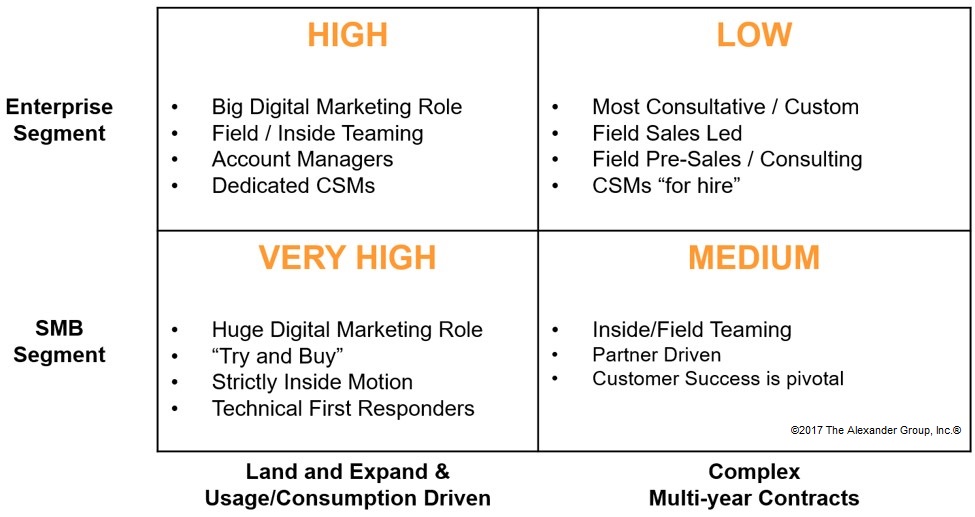Adapting Your Sales Model to the As-a-Service Buyer Journey
Picture the following scenario: It’s the end of the second sales quarter. The place is the Executive Leadership meeting. The CEO shares how the forecast for the year is coming up short by $10M; and she turns to you, the head of sales, and asks, “What do you need to close the gap?”
Product vs. As-a-Service Thinking
In Alexander Group’s experience, about 70 percent of the time the head of sales responds, “No problem, give me five (or six, or 10) more sales reps, and we’ll get it done.” Attaching quota to sales headcount is a time-tested tradition. But is this the best answer? Given how buyer behavior is changing and technology options continue to advance, how should investments in the sales function adapt? More specifically, as many companies look to expand their business models to include “as-a-service” offerings, how should sales leaders adapt the sales organization?
The traditional Enterprise sales model consumes about 90 percent of the budget with high-cost field sales representatives. This model, while effective in certain circumstances, is increasingly ineffective and costly in many others. The as-a-service sales model calls for only 40 percent investment in highly experienced field sales. Sales leaders should re-allocate the other 50 percent to new digital marketing, inside sales and customer success roles. In this new reality, the simple answer of “add another field sales person” is no longer valid.
The As-a-Service Buyer Journey
The as-a-service buyer journey starts with you and continues beyond the sale. Buyers are taking control of the buying process and experience, creating new terms and conditions for vendors. Mark Wahlberg accurately captures this sentiment in AT&T’s latest commercial: “Attention, we…the entertainment loving people of America, have updated our terms and conditions” and ends with the phrase, “We just want all our stuff, the way we want all our stuff.” This is driving broad sweeping change from a transaction-based economy to a subscription and consumption economy, epitomized by the movement to “everything as a service” (XaaS). This shift in business models is driving a dramatic shift in sales models.
Impact on the Sales Process
The sales process must adapt to this new buyer journey. The sales process has shifted from “Access, Persuade, Fulfill” to “Land, Adopt, Expand, Renew.”¹ If buyers choose to self-educate with digital, social and third-party research, the revenue officers must deploy digital marketing tools to access, engage and enable buyers in their self-discovery process. High-cost field sales may not be necessary to initially land new customers. Even traditional “smile and dial” lead generation reps may not be required. Instead, sales leaders might deploy a new type of lead management resource: a technically savvy “first responder” who manages freemium or low cost trial users, assisting to “right fit” them with the right service level option. Once a customer is landed, an inside seller can expand opportunities with a field seller assisting with large and or complex expand opportunities.
When to Shift 50 Percent of Sales Investment
Companies in the process of adding “as-a-service” offerings or evolving to an as-a-service business model need to consider WHEN and HOW to transition the sales force. Begin by examining the complexity of the offering and the complexity of your buyer landscape. To illustrate, consider the 2×2 below, where more complex offerings and buyers call for a more consultative and higher touch (and higher cost) approach. For simpler offerings with smaller but meaningful starting points (freemiums, trials, shorter subscription periods), sales leaders can leverage a lower touch (and lower cost) approach.
As-a-Service Buyer Journey Impact

How to Start to Adapt Your Sales Model
For most companies with large, existing field sales forces, this transition will take time. But, revenue leaders can begin taking some immediate actions while they plan a more comprehensive migration strategy. Here are five action steps to consider:
- Start saying “go-to-customer.” This shift begins with a change in mindset. Most leaders talk in terms of product and go-to-market strategy. Shift this language to become customer-centric. The next time you conduct a planning session, start using the term “go-to-customer.”
- Innovate how you deliver “product.” Much of the “as-a-service” economy is about taking the same goods but making them available in an easier, subscription- or usage-based fashion. This is not exactly a new concept. How can it apply to your business?
- Change your messaging from “what it is” to “what it does.” The transaction economy is based on products with certain features and benefits. The subscription economy is driven by value–results, outcomes and impact.
- Map your buyer journey and design roles to match. Don’t be stuck with the status quo. Take a fresh look at how your customers buy, and use high-cost sellers only where absolutely needed.
- Align KPIs and incentives. The “as-a-service” model requires different measures. Consider what new measures drive usage and value delivery–not just product sales.
Chances are your business faces the need to adapt and migrate to the new buyer journey. Don’t be a sitting duck. The Arctic Turn travels 44,000 miles each year as it migrates from Greenland to Antarctica and back.
¹ Technology Services Industry Association
To discuss how to evaluate and adapt your sales model, please contact an Alexander Group practice leader.
Original author: Paul Vinogradov